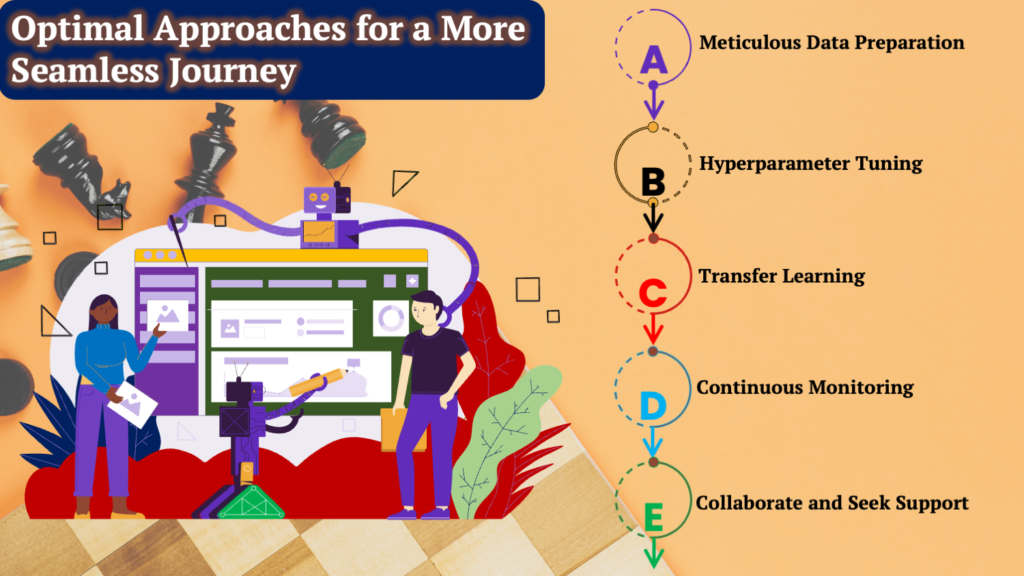To Share is to Show You Care!
In the rapidly evolving field of artificial intelligence, the process of training AI models can often feel like a wild rollercoaster ride. From excitement to frustration, the emotional journey can be intense. But fear not, as we dive into 2023 with cutting-edge strategies and tips for conquering the AI training journey. In this blog post, we’ll explore the best practices to keep you on track and ensure your AI models not only perform at their best but that your sanity remains intact.
1. Understanding the AI Training Rollercoaster
The Ups and Downs of AI Model Training,

1.1 Initial Excitement

At the beginning of the AI model training process, there’s a sense of excitement and anticipation. You’re embarking on a journey to create something innovative and potentially groundbreaking. The possibilities seem limitless, and you’re driven by curiosity and optimism.
1.2 Frustration
As you proceed with training your AI model, you’re likely to encounter various challenges. These can include technical issues, unexpected roadblocks, and uncertainties about whether your model will perform as expected. Frustration can set in as you grapple with these hurdles.

1.3 Overcoming Hurdles

While frustration can be daunting, it’s often followed by a sense of accomplishment when you successfully tackle the challenges. Overcoming these hurdles is an important part of the journey, and it can provide a feeling of progress and competence.
1.4 Data Blues
Data is the lifeblood of AI models, and dealing with data-related issues can be emotionally taxing. This includes issues like data quality problems, insufficient data, or difficulties in collecting and labeling data. Addressing these concerns can be both time-consuming and demanding.

1.5 Model Evaluation Anxiety

As you reach the stage of evaluating your model’s performance, anxiety can set in. You’re eager to see how well your model is doing, and the results can be nerve-wracking. This phase often involves comparing your model’s performance against benchmarks and expectations.
1.6 Achieving Success
If all goes well, the rollercoaster ride concludes with a sense of achievement and satisfaction. Successfully training an AI model is a significant accomplishment and can bring a surge of positive emotions.

2. Best Strategies for a Smoother Ride

2.1 Meticulous Data Preparation

Start with Clean Data: Clean, well-structured data is the foundation of a successful AI model. This means removing duplicates, handling missing values, and ensuring your data is properly formatted.
Data Augmentation: Data augmentation involves creating additional training data by making minor modifications to your existing dataset. This helps your model generalize better and perform well on diverse data.
Data Quality Checks: Regularly check the quality of your data, and implement measures to address issues promptly. Quality checks might include outlier detection, ensuring data consistency, and verifying the accuracy of labels.
2.2 Hyperparameter Tuning
Automated Optimization: Use automated tools or frameworks to optimize hyperparameters, which are configuration settings that control how your model learns. Automated optimization techniques can save time and improve your model’s performance.
Exploring Combinations: Experiment with various combinations of hyperparameters to fine-tune your model effectively. This involves systematically testing different values for parameters like learning rates, batch sizes, and network architectures.

2.3 Transfer Learning

Leveraging Pre-trained Models: Transfer learning involves using pre-trained models as a starting point for your own model. This approach saves time and resources since the pre-trained model has already learned useful features. You can fine-tune it for your specific task.
2.4 Continuous Monitoring
Regular Performance Tracking: Continuously monitor your model’s performance during and after training. This involves tracking metrics such as accuracy, precision, and recall. Monitoring helps you detect issues early and make necessary adjustments.
Early Warning Systems: Implement early warning systems that can alert you to anomalies or deteriorating performance. These systems can trigger notifications when your model’s performance deviates significantly from the expected.

2.5 Collaborate and Seek Support

AI Communities: Join online AI communities and forums to connect with other AI enthusiasts and professionals. These platforms can provide valuable insights, advice, and solutions to common challenges.
Peer Collaboration: Collaborate with peers and mentors who have experience in AI model training. Learning from others’ experiences can help you navigate the emotional ups and downs of AI model development more effectively.
2.6 Patience and Persistence
Understand the Process: Recognize that AI model training is a complex process that can be time-consuming and challenging. Understanding this from the start can help you manage your expectations and emotional responses.
Stay Persistent: The key to success in AI model training often lies in persistence. Challenges are inevitable, but staying committed to your goal and problem-solving can lead to rewarding outcomes.

Conclusion
As we ride the AI model training rollercoaster in 2023, it’s crucial to equip ourselves with the best strategies and a mindset that can handle the emotional twists and turns. By implementing the strategies mentioned above, you can maintain your sanity while conquering the challenges of AI model training.
Remember, with the right approach and a touch of perseverance, you can indeed tame the AI beast and enjoy the exhilarating journey to successful AI model deployment. Strap in, hold tight, and let’s conquer the AI training rollercoaster together!
Are you ready to conquer the AI training rollercoaster in 2023? Share your thoughts and experiences in the comments below!
Frequently Asked Questions
Q1: Is it hard to train an AI model?
A: Training an AI model can be challenging, but it varies based on factors like complexity, data availability, and one’s background in AI.
Q2: Which type of issues can be faced while training a model?
A: Issues during training can include data quality problems, overfitting, underfitting, lack of compute resources, and selecting appropriate hyperparameters.
Q3: Why is it so hard to learn AI?
A: Learning AI can be challenging due to its multidisciplinary nature, requiring a grasp of mathematics, programming, and a deep understanding of algorithms.
Q4: How hard is it to learn AI machine learning?
A: Learning machine learning within AI can be moderately difficult, necessitating a strong foundation in math and programming.
Q5: How long does it take to train an AI model?
A: Training time varies widely, from minutes for simple models to weeks for complex ones, contingent on data size and model complexity.
Q6: Can a normal person learn AI?
A: Yes, anyone with dedication and a willingness to learn can study and grasp AI concepts and techniques.
Q7: What is a major challenge in training a good model?
A: One major challenge is obtaining high-quality labeled data for training, especially in supervised learning.
Q8: What are two major issues in training deep learning models?
A: Overfitting (model learning the training data too well) and vanishing/exploding gradients (difficulties in deep neural networks) are common issues.
Q9: What is the most common issue faced by machine learning models?
A: Overfitting, where a model performs well on the training data but poorly on unseen data, is a common issue in machine learning.
Q10: What are the difficulties of AI?
A: Difficulties in AI include data acquisition, model selection, hyperparameter tuning, and staying updated in a rapidly evolving field.
Q11: What is the easiest AI to learn?
A: Linear regression is often considered one of the easiest AI algorithms to learn due to its simplicity and clear mathematical foundation.
Q12: Is AI more difficult than software engineering?
A: AI can be more challenging than traditional software engineering due to the need for both software development skills and a deep understanding of AI concepts.
Q13: Can I learn AI in 3 months?
A: It’s possible to acquire basic AI knowledge in three months, but mastering the field typically takes longer due to its breadth and complexity.
Q14: How much does it take to train an AI model?
A: Training time depends on factors like data size, model complexity, and hardware. It can range from minutes to weeks or even longer.
Q15: Can I learn AI without coding?
A: Basic AI concepts can be learned without coding, but practical AI implementation typically requires coding proficiency in languages like Python.
The Informed Minds
I'm Vijay Kumar, a consultant with 20+ years of experience specializing in Home, Lifestyle, and Technology. From DIY and Home Improvement to Interior Design and Personal Finance, I've worked with diverse clients, offering tailored solutions to their needs. Through this blog, I share my expertise, providing valuable insights and practical advice for free. Together, let's make our homes better and embrace the latest in lifestyle and technology for a brighter future.

